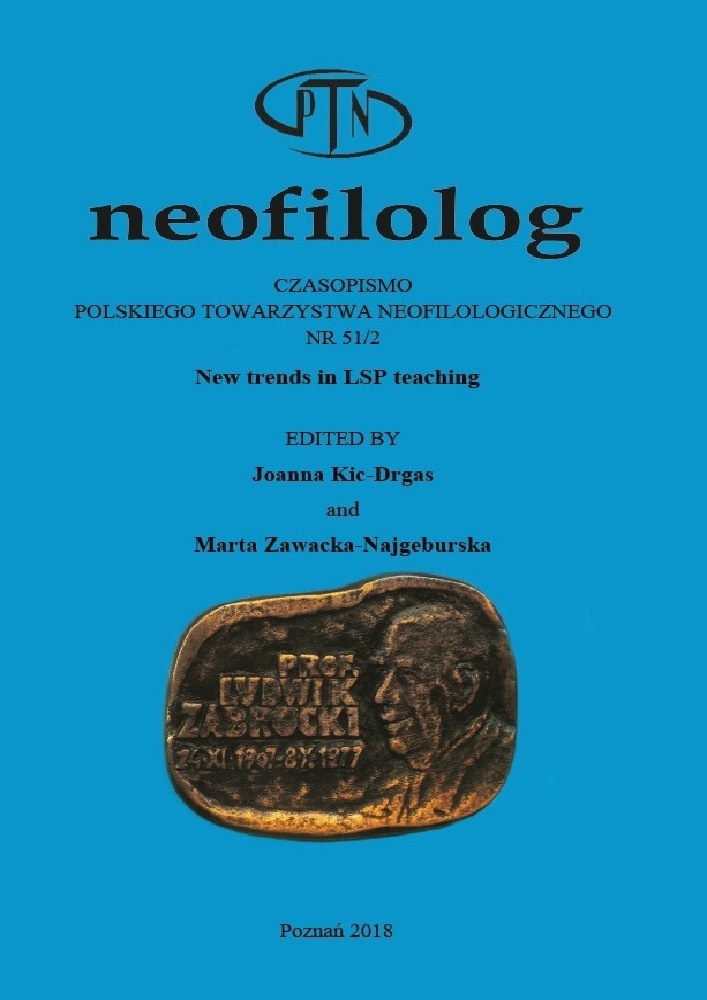Abstrakt
In the following paper the author presents selected theories and approaches related to the translation of songs. She believes that these are crucial in understanding the melic translation process. Some aspects of the melic translation process itself, especially those connected with the translator’s decision, are also mentioned. They are described in order to show the need for an interdisciplinary perspective when approaching the topic. The main aim of the article is to present a possible solution for song translation with reference to the theories presented. The solution proposed involves the need to keep in mind not only ‘the message’ of the song, semantic dominant, harmonic dominant, and ‘the sound’ but also the fact that children are the main recipients.
Bibliografia
Baluch J. (ed.) (2006), Przekład literatury dziecięcej. “Przekładaniec”, No 16, pp. 41-56.
Baluch J. (ed.) (2004), Z teorii i historii przekładu artystycznego. Kraków: Uniwersytet Jagielloński.
Barańczak S. (2004), Ocalone w tłumaczeniu. Szkice o warsztacie tłumacza poezji z dodatkiem małej antologii przekładów i problemów. Kraków: Wydawnictwo AP.
Barańczak S. (1974), Przekład artystyczny jako “samoistny” i “związany” obiekt interpretacji (in) Baluch J. (ed.), Z teorii i historii przekładu artystycznego. Kraków: Uniwersytet Jagielloński, pp. 47-74.
Barańczak S. (1992), Rice pudding i kasza manna. Ocalone w tłumaczeniu. Poznań: Wydawnictwo a5.
Bednarczyk A. (1993), Przekład poezji śpiewanej a odtworzenie w nim warstwy muzycznej oryginału (in) Semczuk A., Zwarzer W. (eds), Literatura i słowo wczoraj i dziś. Piśmiennictwo rosyjskie a państwo totalitarne, Materiały konferencji naukowych (10-11 czerwca). Warszawa: Instytut Rusycystyki Uniwersytetu Warszawskiego, pp. 135-141.
Bednarczyk A. (2005), Murka warianty intra- i interlingwalne. (Jeszcze raz o tłumaczeniu piosenki) (in) Fast P. (ed.), Kultura popularna a przekład. Katowice: Wydawnictwo Naukowe „Śląsk”, pp. 123-139.
Bednarczyk A. (1995), Wysocki po polsku. Problematyka przekładu poezji śpiewanej. Łódź: Wydawnictwo Naukowe UŁ.
Bristiger M. (1986), Związki muzyki ze słowem. Z zagadnień analizy muzycznej. Warszawa: Polskie Wydawnictwo Muzyczne.
Bryll A. (2006), Zyski i straty w filologicznych i melicznych przekładach piosenek Stinga (in) Fast P., Janikowski P. (eds), Dialog czy nieporozumienie? Z zagadnień krytyki przekładu. Katowice: “Śląsk”.
Bryll A. (2012), Semantic dominant feature in melic (over?) translation of song (in) Bryll A., Sikora I. M., Walczyński M. (eds), Philological Inquiries. Nysa: Publishing Office PWSZ Nysa, pp. 85-100.
Burzyńska A., Markowski M. P. (2007), Teorie literatury XX wieku. Podręcznik, Kraków: Wydawnictwo ZNAK.
Christiansen B. (1914), Filozofia sztuki. Warszawa: Warszawa: Księgarnia F. Hoesicka.
Jakobson R., Tynianow J. (1978), Problemy badań nad literaturą i językiem, translated by E. Korpała-Kirszak (in) Tynianow J. (ed.), Fakt literacki. Warszawa.: Wydawnictwo P.I.W, pp. 5-11.
Kolago L. (1997), Musikalische formen und Strukturen in der deutschsprachigen Literatur des 20. Jahrhunderts. Salzburg: Verlag Muller-Speiser.
Krysztofiak M. (2011), Translatologiczna teoria i pragmatyka przekładu artystycznego. Poznań: Wydawnictwo Naukowe UAM.
Osadnik W. (2006). »Ja«, »ty«, »my«, »wy« pogubione w polskim przekładzie utworów Leonarda Cohena (in) Fast P., Osadnik W. (eds), Przekład jako komunikat. Katowice: Wydawnictwo Naukowe „Śląsk”, pp. 135-149.
Osadnik W., Nowinka A. (2006a), The Problem of Equivalence in Translation of Songs (in) Fast P., Osadnik W. (eds), Przekład jako komunikat. Katowice: Wydawnictwo Naukowe „Śląsk”, pp. 103-115.
Puurtinen, T. (1995), Linguistic Acceptability in Translated Children’s Literature. Joensuu: University of Joensuu.
Piaget J., Inhelder B. (1956), The Child’s Conception of Space. London: Routlege and Kegan Paul.
Tomaszewski M. (2003), Muzyka w dialogu ze słowem. Kraków: Akademia Muzyczna.
Zagórski J. (1995), Tłumaczenie oper i sztuk pisanych wierszem. O sztuce tłumaczenia. Wrocław: Zakład im. Ossolińskich.
Zazula P. (1999), Dominanta dramatyczna w przekładach tekstów piosenek (in) Dąbska-Prokop U. (ed.), Przekład literacki a przekład użytkowy. Teoria i praktyka. Częstochowa: Educator, pp. 100-116.
Licencja
Prawa autorskie (c) 2018 Weronika Szota

Utwór dostępny jest na licencji Creative Commons Uznanie autorstwa – Bez utworów zależnych 4.0 Międzynarodowe.
Przedstawiany utwór (artykuł) upubliczniany jest na podstawie umowy z autorem i na licencji Creative Commons Attribution-NoDerivatives 4.0 International (CC BY-ND 4.0).
Użytkownicy mają obowiązek podania wraz z rozpowszechnionym utworem, informacji o autorstwie, tytule, źródle (odnośniki do oryginalnego utworu, DOI) oraz samej licencji;
- bez tworzenia utworów zależnych,
- utwór musi być zachowany w oryginalnej postaci.
Uniwersytet im. Adama Mickiewicza w Poznaniu zachowuje prawo do czasopisma jako całości (układ, forma graficzna, tytuł, projekt okładki, logo itp.).

